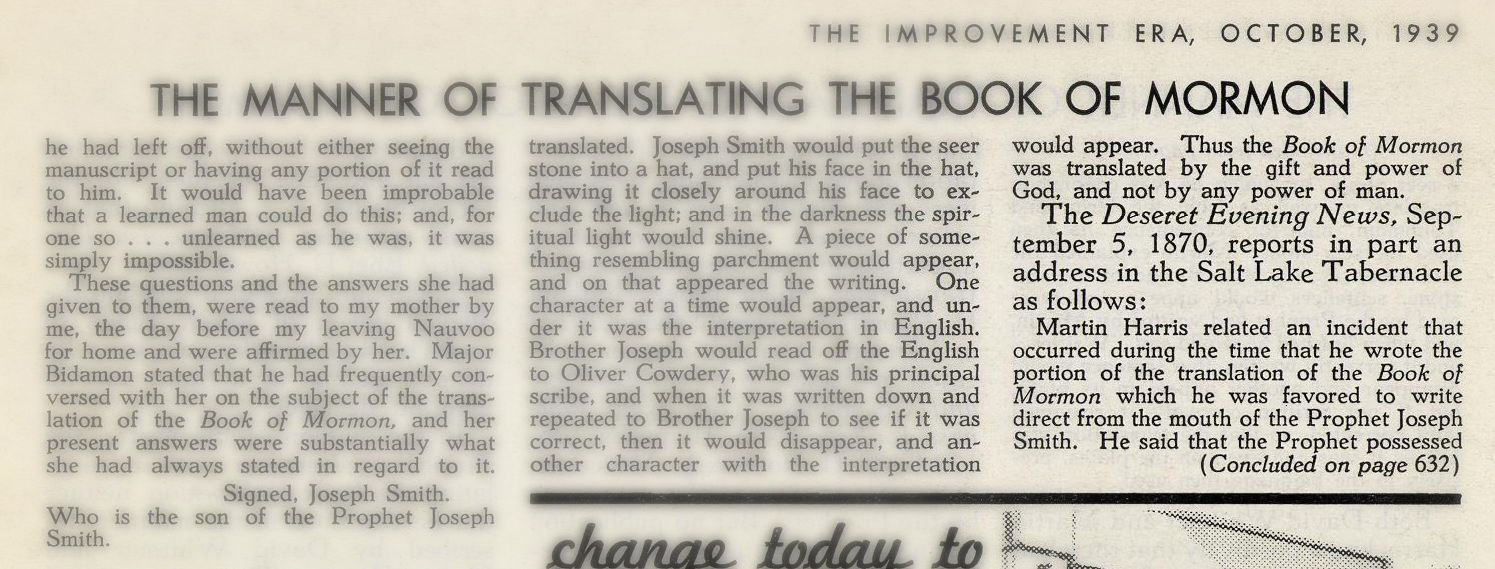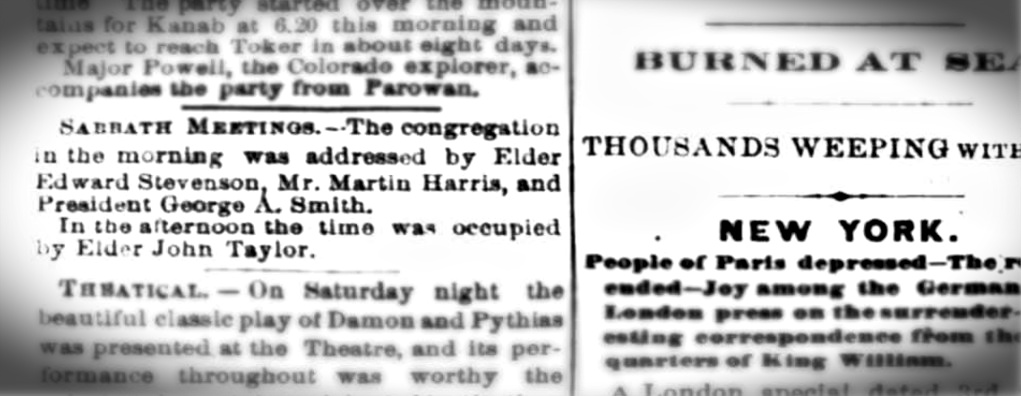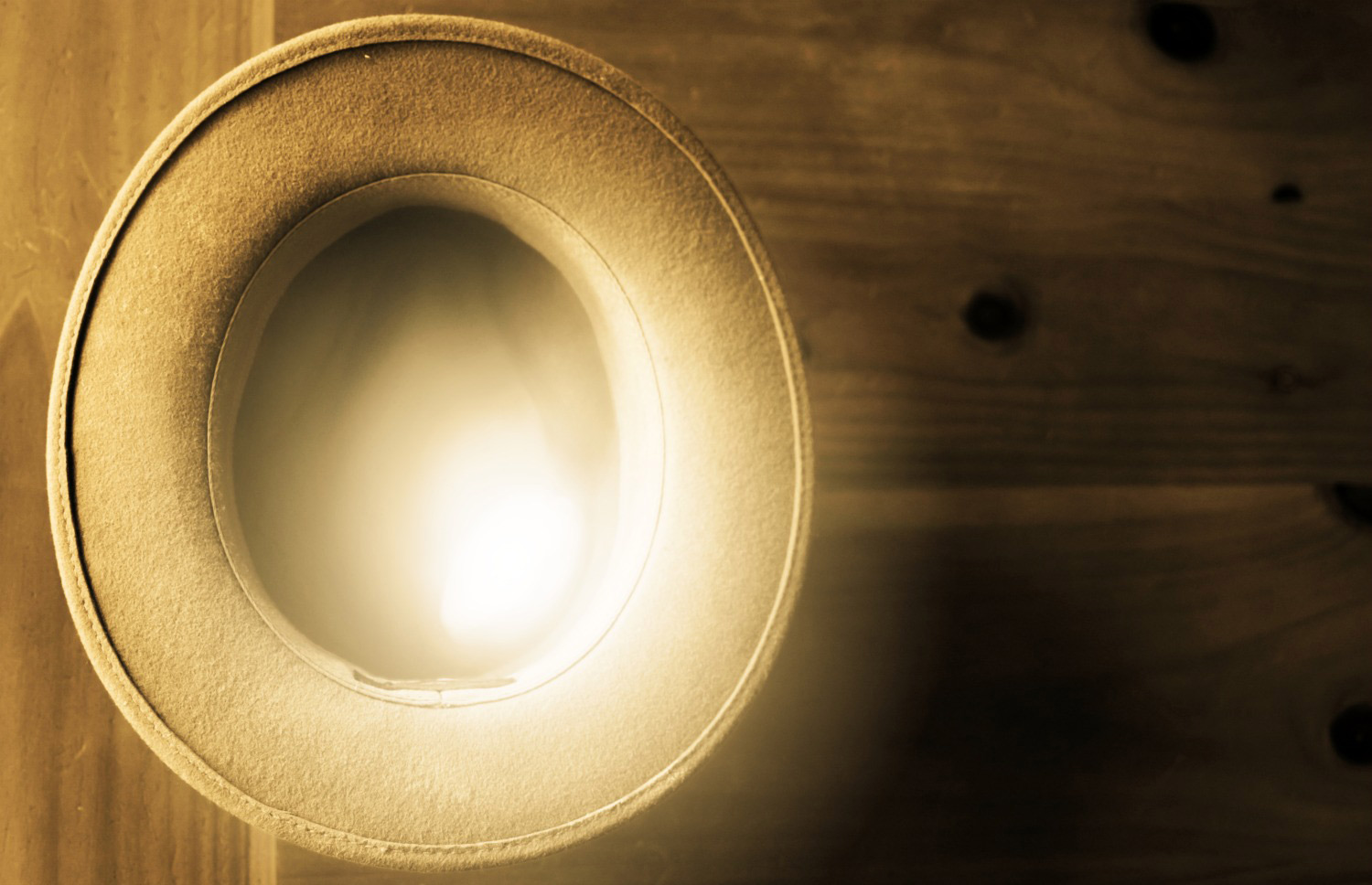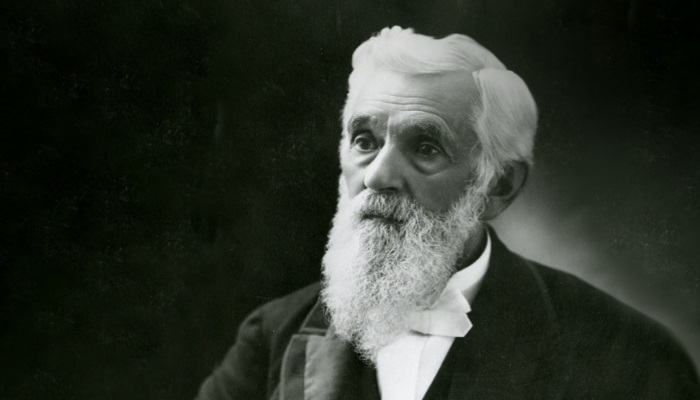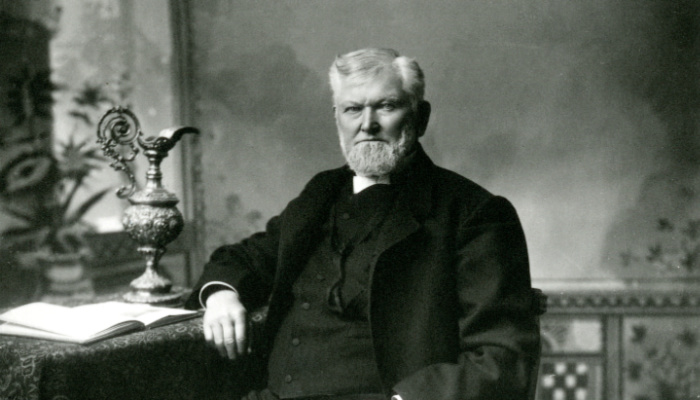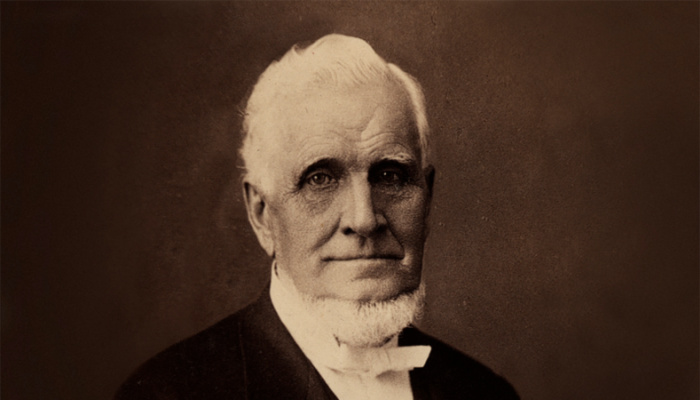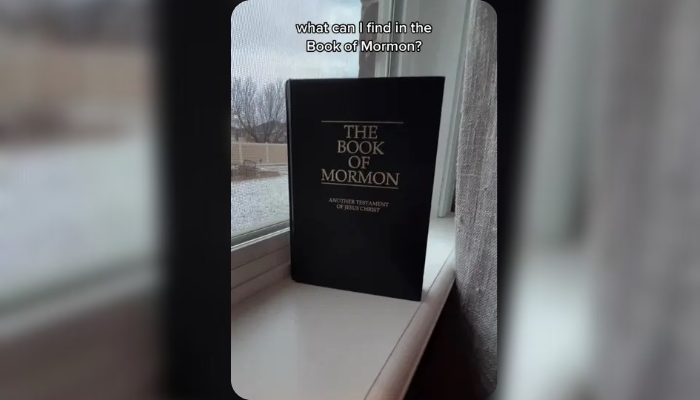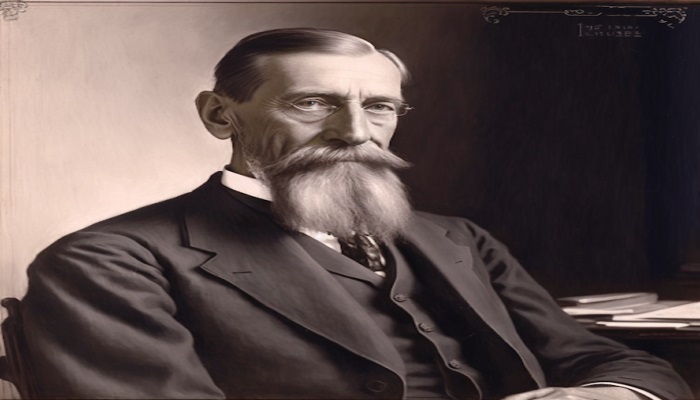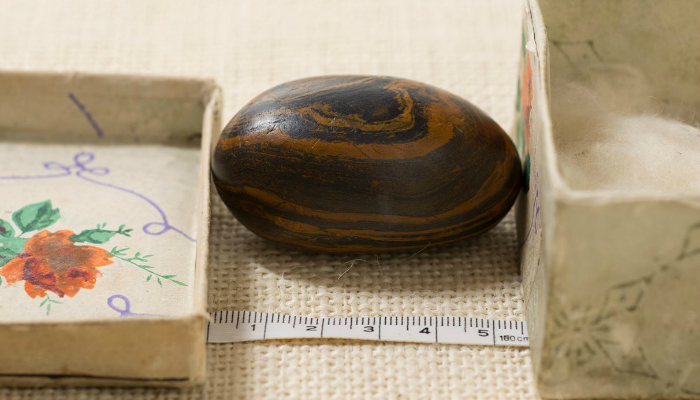
Did the Church Try to Hide Joseph’s Use of a Seer Stone to Translate the Book of Mormon?
Joseph Smith’s chief scribe during the translation of the Book of Mormon, Oliver Cowdery, reported the following in 1831:
Brother Hyrum Smith said that he thought best that the information of the coming forth of the book of Mormon be related by Joseph himself to the Elders present that all might know for themselves.
Brother Joseph Smith Jr. said that it was not intended to tell the world all the particulars of the coming forth of the book of Mormon, & also said that it was not expedient for him to relate these things &c.
Looking back from almost 200 years later, it seems Joseph was quite successful with that sentiment. Very little is actually known about how the Book of Mormon was translated. The most common response by the two men who surely knew the most on this subject was simply,
It was translated by the gift and power of God, with the aid of the Urim and Thummim.
What about Joseph’s seer stone?

Over time, historic figures such as Martin Harris attempted to shed more light on the subject and affirmed that in addition to the Urim and Thummim, Joseph Smith used his personal seer stone to help translate.
This has eventually become the official position of the Church. It may have been possible that since the seer stone and the Urim and Thummim served the same purpose, the term “Urim and Thummim” was used by Joseph and Oliver as more of a category of translation instruments, as opposed to one specific instrument.
That said, it seems (and if I’m wrong about this, someone please point it out) that Joseph himself never mentioned he even possessed a seer stone, and never unambiguously said anything about using it to translate. The earliest published record that I’m aware of that mentions his use of such a stone as a translation tool comes from the notoriously anti-Latter-day Saint book, Mormonism Unveiled (1834). It is, therefore, no surprise that further claims that Joseph had used said stone for translation purposes were met with caution from early Church leaders.
In fact, in reference to Mormonism Unveiled‘s claim, Dr. Francis Kirkham wrote in a 1939 edition of the Improvement Era,
This is an attempt to explain the alleged power of Joseph Smith to translate the plates by a person who denounced him as a fraud and an ignorant deceiver.
Some may view this as an early attempt to “cover-up” this potentially-embarrassing information about Joseph. But as we’ve seen, there was simply very little known about Joseph’s translation method in the early days of the Church. It seems to me that Kirkham simply disagreed with the evidence that was then available.
The earliest Church source to mention the seer stone as a translation tool
[UPDATE 12/16/2020: Thank you to Scott Vance, who recently brought to my attention an even earlier source (published by the Church or Church-owned entities) than the one included below. On November 11, 1881, the Deseret Evening News re-published an October 14 letter that was originally published in the Chicago Times:
The tablets or plates were translated by Smith, who used a small oval or kidney-shaped stone, called Urim and Thummim, that seemed endowed with the marvellous [sic] power of converting the characters on the plates, when used by Smith, into English, who would then dictate to Cowdery what to write. frequently, one character would make two lines of manuscript while others made but a word or two words. Mr. Whitmer emphatically asserts, as did Harris and Cowdery, that while Smith was dictating the translation he had not manuscript notes or other means of knowledge, Save the Seer stone and the characters as shown on the plates, he being present and cognizant how it was done.
Deseret Evening News then went on to correct a few errors in the letter:
The next error is that the seer stone which Joseph used in the translation ‘was called Urim and Thummim,’ The instrument thus denominated was composed of two crystal stones ‘set in the two rims of a bow.’ The seer stone was separate and distinct from the Urim and Thummim. The latter was delivered to the angel as well as the plates after the translation was completed; the former remained with the Church and is now in the possession of the President.
Read the original newspaper here.]
I may have heavily belabored the following point, but I spent a lot of time researching it, so gosh-darn-it here it is in all of its glory:
The earliest source I can find in reference to the seer stone as a translation instrument that has been published by the Church or a Church-owned entity dates back to 1884. In an 1882 edition of the Millennial Star, Edward Stevenson wrote:
Monday Evening News, Steptember [sic] 5, 1870, contains the following:
‘Sabbath Meetings. —The congregation in the morning was addressed by Elder Edward Stevenson, Martin Harris and President George A. Smith. In the afternoon the time was occupied by Elder John Taylor, the house was crowded to overflowing.’
Martin Harris related an incident that occurred during the time that he wrote that portion of the translation of the Book of Mormon which he was favored to write direct from the mouth of the Prophet Joseph Smith. He said that the Prophet possessed a seer stone, by which he was enabled to translate as well as from the Urim and Thummim, and for convenience he then used the seer stone. Martin explained the translation as follows: By aid of the seer stone, sentences would appear and were read by the Prophet and written by Martin, and when finished he would say, ‘Written,’ and if correctly written, that sentence would disappear and another appear in its place, but if not written correctly it remained until corrected, so that the translation was just as it was engraved on the plates, precisely in the language then used.
The Millennial Star predicament
You just read that the earliest reference I was able to find comes from the above-quoted 1882 edition of the Millennial Star, but you probably noticed that the Star is referencing an 1870 edition of the Evening News. Note that the September 5 Evening News is referring to Sunday meetings that would have occurred the previous day on Sunday, September 4, 1870.
The problem with the 1882 paper is that while the second paragraph certainly seems to be alluding to an event that happened at the September 1870 meeting, only the first paragraph is a quotation from the Evening News newspaper. The experience related by Martin Harris does not appear there. It may have been accidentally attributed directly to the Evening News by Francis Kirkham in the aforementioned 1939 edition of the Improvement Era:
The Deseret Evening News, September 5, 1870, reports in part an address in the Salt Lake Tabernacle as follows:
Martin Harris related an incident that occurred during the time that he wrote the portion of the translation of the Book of Mormon which he was favored to write direct from the mouth of the Prophet Joseph Smith. He said that the Prophet possessed a seer stone, by which he was enable to translate…
But, again, the Deseret Evening News contains no such experience. Here’s a screenshot of everything that issue had to say on the matter:
It could be that Kirkham is getting his information from the 1882 Millennial Star. So, the question is, did Martin actually relate this experience in that September 1870 meeting? I believe he did. We get hints of it in Joseph F. Smith’s journal for the day in question:
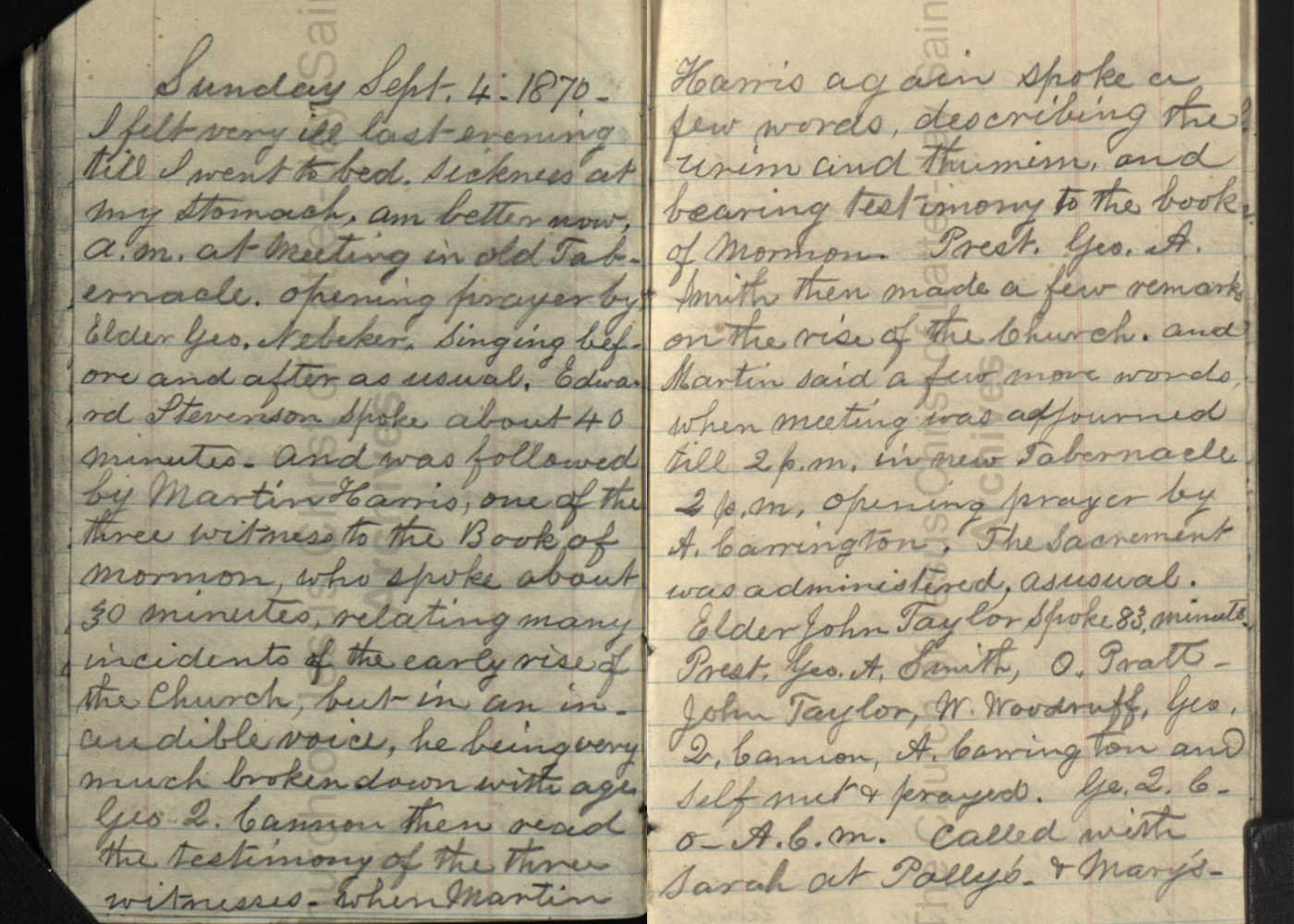
Sunday Sept. 4. 1870-
I felt very ill last evening till I went to bed. Sickness at my stomach, am better now, a.m. at meeting in old Tabernacle. Opening prayer by Elder Geo. Nebeker. Singing before and after as usual. Edward Stevenson spoke about 40 minutes- and was followed by Martin Harris, one of the three witnesses to the Book of Mormon, who spoke about 30 minutes, relating many incidents of the early rise of the Church, but in an inaudible voice, he being very much broken down with age. Geo. Q. Cannon then read the testimony of the three witnesses. When Martin Harris again spoke a few words, describing the urim and thumim, and bearing testimony to the book of Mormon. Prest. Geo. A. Smith then made a few remarks on the rise of the Church. and Martin said a few more words, when meeting was adjourned till 2 p.m. in the new Tabernacle.
Further study is needed to determine if other journal accounts are available. The most likely explanation seems to be that Edward Stevenson was present at the 1870 meeting (as attested to in the actual Evening News quotation) and recollected the account years later for the Millennial Star.
Hence, the first Church-published mention of the stone used as a translation tool comes from 1882, but seems to be recollected from an 1870 event.
What about sources not published by the Church?

There are other sources that report Joseph’s use of a seer stone as a translation tool, but all of them (that I’m aware of) come from outside the Church, and often from hostile sources, or from disaffected members (which would include Martin Harris for a few decades and David Whitmer). As such, again, it’s not surprising that the Church wouldn’t lend much credence to these sources. Even after Martin Harris returned to the Church and began telling members about the seer stone, some members and leaders did not believe him.
Again from Kirkham in 1939:
In the opinion of the writer, the Prophet used no seer stone in translating the Book of Mormon, neither did he translate in the manner described by David Whitmer and Martin Harris. The statements of both of these men are to be explained by the eagerness of old age to call upon a fading and uncertain memory for the details of events which still remained real and objective to them.
And even from Elder Joseph Fielding Smith in 1956 [full quote listed later on]:
…While the statement has been made by some writers that the Prophet Joseph Smith used a seer stone part of the time in his translating of the record, and information points to the fact that he did have in his possession such a stone, yet there is no authentic statement in the history of the Church which states that the use of such a stone was made in that translation. The information is all hearsay, and personally, I do not believe that this stone was used for this purpose. … It may have been so, but it is so easy for a story of this kind to be circulated due to the fact that the Prophet did possess a seer stone, which he may have used for some other purposes.
And frankly, I see where Elder Smith was coming from. The sources reporting Joseph’s use of the stone as a translation tool seem to be wholly non-Latter-day Saint until the newly re-baptized 87-year-old Martin Harris starts talking about it.
What’s the point of all this stuff about the seer stone?
Not long ago a man reached out to me having felt deceived by The Church of Jesus Christ of Latter-day Saints. He’d taken issue with the fact that he’d been a long-time member before he heard that Joseph translated the Book of Mormon using (largely) a seer stone placed inside a hat. He claimed that the Church had been hiding this information from the public because of its ties to some Christian folk-magic practices common to Joseph’s era. And it wasn’t until the popular television show South Park mockingly brought the seer stone to light in 2003 that the Church was forced to be more transparent.
Related: How Exactly Did Joseph Smith Translate the Book of Mormon?
His accusations have stuck with me. Since that conversation, I’ve kept my eyes out for references to Joseph’s seer stone from past decades. Could it be true? Is this a topic the Church has been sweeping under the rug in the past? As I’ve waded through the archives of history in search of relevant information, I’ve come to a few conclusions:
The Church has published more about Joseph seer stone than critics may have you believe, but they still haven’t published a whole lot. The question we’re confronted with is, why? Some people have come to the conclusion that the Church has something to hide. My conclusion is that, as previously stated, information about the stone as a translation tool has been scant and suspect for a long time. To assume that we’ve always known about and had access to the historic sources that we currently have would be a mistake. I see no reason to believe Church leaders have been hiding information, but rather that for many years they simply did not agree among themselves on the interpretation of whatever information was available to them.
In reverse chronological order, the remainder of this article will list several of the Church-published references (including references from Church-owned entities) to the seer stone I’ve discovered so far. This is not a comprehensive list, and more attention has been given to finding early sources, as more recent sources are more readily available.
Revelations of the Restoration, by Joseph Fielding McConkie and Craig Ostler, pg. 89-98, December 2000
Published by Deseret Book Co. This quote is quite extensive, but can be viewed here. In a nutshell, the authors (a couple of Latter-day Saint scholars) disagree with the idea that Joseph used a seer stone to help him translate the Book of Mormon.
“By the Gift and Power of God,” Elder Neal A. Maxwell, Ensign, January 1997

Martin Harris related of the seer stone: ‘Sentences would appear and were read by the Prophet and written by Martin’ (quoted in Edward Stevenson, ‘One of the Three Witnesses: Incidents in the Life of Martin Harris,’ Latter-day Saints’ Millennial Star, 6 Feb. 1882, 86–87).
“A Treasured Testament,” Elder Russell M. Nelson, Ensign, July 1993

Elder Nelson’s message here was apparently “adapted from an address given 25 June 1992 at a seminar for new mission presidents, Missionary Training Center, Provo, Utah.”
Joseph Smith would put the seer stone into a hat, and put his face in the hat, drawing it closely around his face to exclude the light; and in the darkness the spiritual light would shine. A piece of something resembling parchment would appear, and on that appeared the writing. One character at a time would appear, and under it was the interpretation in English. Brother Joseph would read off the English to Oliver Cowdery, who was his principal scribe, and when it was written down and repeated to Brother Joseph to see if it was correct, then it would disappear, and another character with the interpretation would appear. Thus the Book of Mormon was translated by the gift and power of God, and not by any power of man.
“The Restoration Commences, 1820-1831,” The Story of the Latter-day Saints, by James B. Allen and Glen M Leonard, pg. 40-41, 2nd Ed., 1992
Published by Deseret Book.
Sometime around 1822, before his first visit from the angel Moroni, Joseph was digging a well with Willard Chase, not far from the Smith home, and he discovered a smooth, dark-colored stone, about the size of an egg, that he called a seerstone. He later used it to help in the translation of the Book of Mormon and also in receiving certain revelations.
[UPDATE 12/16/2020: Thanks to Scott Vance for pointing out that the seer stone reference in this work was not included until the updated 1992 version of this book, as opposed to the original 1976 edition.]
“By the Gift and Power of God,” by Richard Lloyd Anderson, Ensign, September 1977

As Joseph Smith’s first scribe (during the summer of 1828), Martin Harris spoke with authority of that phase of the translation. But quoting him raises a key issue: everything attributed to him does not necessarily represent his exact words. This caution is necessary because his statements on translation details are filtered through reporters, some with only casual contact, some claiming to remember exact words years later.
The person who best reflects Martin Harris is probably Edward Stevenson, since he spent nearly two months with the Witness after going to Ohio to escort him back to Utah in 1870. On the means of translation Stevenson reported, ‘He said that the Prophet possessed a seer stone, by which he was enabled to translate as well as from the Urim and Thummim, and for convenience he then used the seer stone.’
After Martin Harris lost the part of the translation done in 1828, Oliver Cowdery became chief scribe for the entire Book of Mormon as it is now printed. Toward the end of this new work of 1829, David Whitmer on occasion watched and afterwards spoke of the seer stone. Yet as an intimate assistant, Oliver Cowdery stressed the Urim and Thummim in his statements.
“A Peaceful Heart,” Friend magazine, Sept. 1974
To help him with the translation, Joseph found with the gold plates ‘a curious instrument which the ancients called Urim and Thummim, which consisted of two transparent stones set in a rim of a bow fastened to a breastplate.’ Joseph also used an egg-shaped, brown rock for translating called a seer stone.
Doctrines of Salvation, by Elder Joseph Fielding Smith, Vol 3, pg. 225, 1956
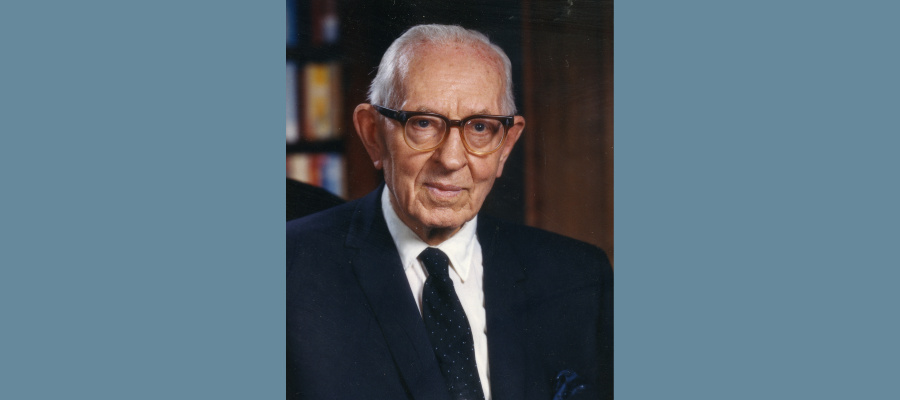
This is an interesting quote. Elder Smith acknowledges that Joseph Smith owned a seer stone, and that the Church was then in possession of it. And while he opines that Joseph didn’t use the stone to help translate, he does admit that “It may have been so….” This tells me that the Church wasn’t trying to hide anything, but rather that they simply didn’t know the manner of translation.
SEER STONE NOT USED IN BOOK OF MORMON TRANSLATION. We have been taught since the days of the Prophet that the Urim and Thummim were returned with the plates to the angel. We have no record of the Prophet having the Urim and Thummim after the organization of the Church. Statements of translations by the Urim and Thummim after that date are evidently errors. The statement has been made that the Urim and Thummim was on the altar in the Manti Temple when that building was dedicated. The Urim and Thummim so spoken of, however, was the seer stone which was in the possession of the Prophet Joseph Smith in early days. This seer stone is now in the possession of the Church.
While the statement has been made by some writers that the Prophet Joseph Smith used a seer stone part of the time in his translating of the record, and information points to the fact that he did have in his possession such a stone, yet there is no authentic statement in the history of the Church which states that the use of such a stone was made in that translation. The information is all hearsay, and personally, I do not believe that this stone was used for this purpose. The reason I give for this conclusion is found in the statement of the Lord to the Brother of Jared as recorded in Ether 3:22-24.
These stones, the Urim and Thummim which were given to the Brother of Jared, were preserved for this very purpose of translating the record, both of the Jaredites and the Nephites. Then again the Prophet was impressed by Moroni with the fact that these stones were given for that very purpose. It hardly seems reasonable to suppose that the Prophet would substitute something evidently inferior under these circumstances. It may have been so, but it is so easy for a story of this kind to be circulated due to the fact that the Prophet did possess a seer stone, which he may have used for some other purposes.
“The Manner of Translating the Book of Mormon,” The Improvement Era, pg 632, October 1939
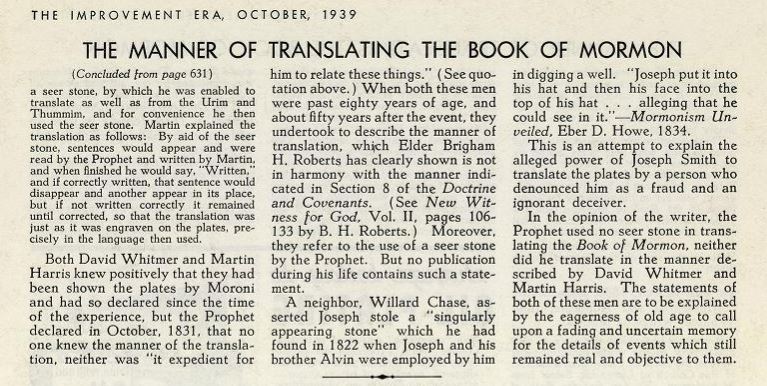
This quote further corroborates the commentary given in the previous section. This author (Dr. Francis Kirkham) disagrees with an earlier author’s assertion (B. H. Roberts) that Joseph used a seer stone to help translate the Book of Mormon. Kirkham does not refute the existence of such a stone, but rather the stone’s role in the translation.
…the Prophet declared in October, 1831, that no one knew the manner of the translation, neither was ‘it expedient for him to relate these things.’ (See quotation above.) When both these men were past eighty years of age, and about fifty years after the event, they undertook to describe the manner of translation, which Elder Brigham H. Roberts has clearly shown is not in harmony with the manner indicated in Section 8 of the Doctrine and Covenants. (See New Witness for God, Vol. II, pages 106-133 by B. H. Roberts.) Moreover, they refer to the use of a seer stone by the Prophet. But no publication during his life contains such a statement.
A neighbor, Willard Chase, asserted Joseph stole a ‘singularly appearing stone’ which he had found in 1822 when Joseph and his brother Alvin were employed by him in digging a well. ‘Joseph put it into his hat and then his face into the top of his hat … alleging that he could see in it.’ —Mormonism Unveiled, Eber D. Howe, 1834.
This is an attempt to explain the alleged power of Joseph Smith to translate the plates by a person who denounced him as a fraud and an ignorant deceiver.
In the opinion of the writer, the Prophet used no seer stone in translating the Book of Mormon, neither did he translate in the manner described by David Whitmer and Martin Harris. The statements of both of these men are to be explained by the eagerness of old age to call upon a fading and uncertain memory for the details of events which still remained real and objective to them.
“Translation of the Book of Mormon,” by B. H. Roberts, Improvement Era, 9 April 1906
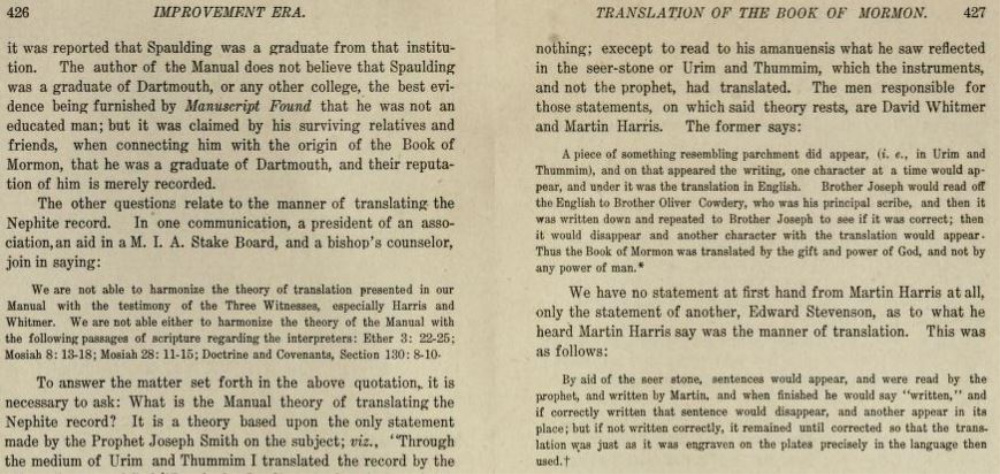
In this, however, they did not follow his wise example; but must needs undertake to describe the manner of the translation; and from such description has arisen the idea that the Urim and Thummim did all, in the work of the translation, the prophet, nothing; except to read to his amanuensis what he saw reflected in the seer-stone or Urim and Thummim, which the instruments, and not the prophet, had translated. …We have no statement at first hand from Martin Harris at all, only the statement of another, Edward Stevenson, as to what he heard Martin Harris say was the manner of translation. This was as follows: ‘By aid of the seer stone, sentences would appear, and were read by the prophet, and written by Martin…’
“The Manner of Translating the Book of Mormon,” New Witnesses For God, by B. H. Roberts, Vol. 2, pg. 106-110, 1903

Published by, The Deseret News, which was/is owned by the Church.
Joseph and Oliver both say the translation was done by means of the Urim and Thummim, which is described by Joseph as being ‘two transparent stones set in a rim of a bow fastened to a breast-plate;’ while David Whitmer says that the translation was made by means of a ‘Seer Stone.’ The apparent contradiction is cleared up, however, by a statement made by Martin Harris, another of the Three Witnesses. He said that the Prophet possessed a ‘Seer Stone,’ by which he was enabled to translate as well as from the Urim and Thummim, and for convenience he then (i.e., at the time Harris was acting as his scribe) used the Seer Stone. *** Martin said further that the Seer Stone differed in appearance entirely from the Urim and Thummim that was obtained with the plates, which were two clear stones set in two rims, very much resembling spectacles, only they were larger.
The ‘Seer Stone’ referred to here was a chocolate-colored, somewhat egg-shaped stone which the Prophet found while digging a well in company with his brother Hyrum. It possessed the qualities of Urim and Thummim, since by means of it—as described above—as well as by means of the ‘Interpreters’ found with the Nephite record, Joseph was able to translate the characters engraven on the plates.
…The sum of the whole matter, then, concerning the manner of translating the sacred record of the Nephites, according to the testimony of the only witnesses competent to testify in the matter is: With the Nephite record was deposited a curious instrument … called by the ancient Nephites ‘Interpreters.’ In addition to these ‘Interpreters’ the Prophet Joseph had a ‘Seer Stone,’ which to him was a Urim and Thummim; that the prophet sometimes used one and sometimes the other of these sacred instruments in the work of translation.
“One of the Three Witnesses,” Millennial Star, pg. 86, Feb. 6, 1882
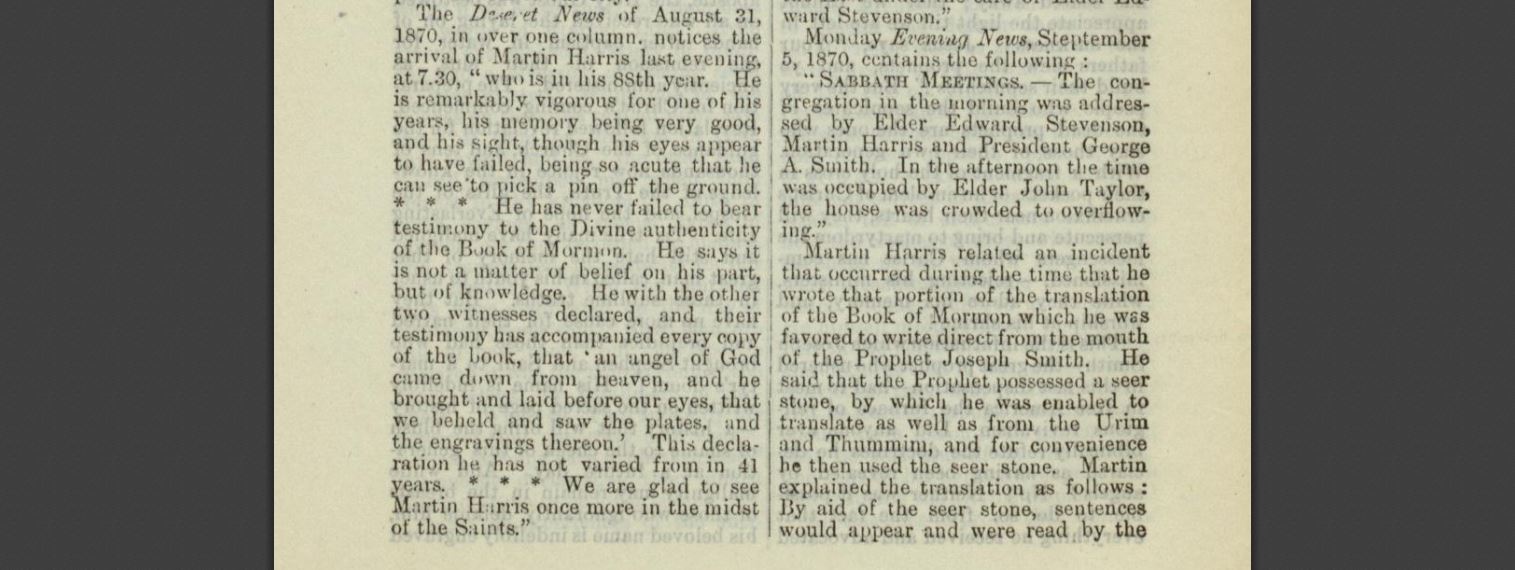
Monday, Evening News, Steptember [sic] 5, 1870, contains the following: …Martin Harris related an incident that occurred during the time that he wrote that portion of the translation of the Book of Mormon which he was favored to write direct from the mouth of the Prophet Joseph Smith. He said that the Prophet possessed a seer stone, by which he was enabled to translate as well as from the Urim and Thummim, and for convenience he then used the seer stone. Martin explained the translation as follows: By aid of the seer stone, sentences would appear and were read by the Prophet and written by Martin, and when finished he would say, ‘Written,’ and if correctly written, that sentence would disappear and another appear in its place, but if not written correctly it remained until corrected, so that the translation was just as it was engraved on the plates, precisely in the language then used.


